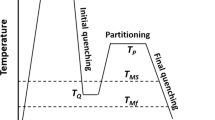Abstract
TWIP (twinning-induced plasticity) steels emerge as promising materials for the automotive industry, non-magnetic applications, and oil-and-gas exploration. The aims of this paper is to study fiber laser welding of TWIP steel thin sheets from mechanical behavior and microstructural points of view. The samples were laser-welded with speeds of 50, 100, and 150 mm/s keeping the power constant at 1200 W. These three conditions resulted in weld bead 0.2 to 0.4 mm wide without cracks or pores. According to the analyses, the austenite (FCC) dendritic growth occurred from the fusion line to the center of the weld where an equiaxed grain region is observed. The fine equiaxed grains gave rise to a hardness peak compared to surrounding regions of the fusion and heat-affected zones in accordance with the Hall-Petch effect. The heat-affected zone presented a drop in hardness due to the annealing of the cold rolled base material. The tensile shear strength of the laser-welded coupons ranged between 6300 and 10,500 N, which is above the standard limit of 4.5 kN established for electric resistance spot welds. The formability analysis, using Erichsen tests, has shown high ductility with the Erichsen Index of approximately 10 for 0.7 tons-force load.








Similar content being viewed by others
References
Bai Y, Momotani Y, Chen MC, Shibata A, Tsuji N (2016) Effect of grain refinement on hydrogen embrittlement behaviors of high-Mn TWIP steel. Mater Sci Eng A 651:935–944
Wei Y, Li Y, Zhu L, Liu Y, Lei X, Wang G, Gao H (2014) Evading the strenght-ductiity trade-off dilemma in steel through gradient hierarchical nanotwins. Nat Commun 5:1–8
Hwang JK, Yi IC, Son IH, Yoo JY, Kim B, Zargaran A, Kim NJ (2015) Microstructural evolution and deformation behavior of twinning-induced plasticity (TWIP) steel during wire drawing. Mater Sci Eng A 644:41–52
Cooman, B. C. De, Estrin, Y., & Kim, S. K. (2018) Twinning-induced plasticity ( TWIP ) steels. Acta Materialia, 1-80
Keeler S, Kimchi M, Kuziak R, Kawalla R, Waengler S, Yuqing W, Han Dong YG (2014) Advanced high strength steels for automotive industry. Arch Civ Mech Eng 8(2):511
Chen S, Rana R, Haldar A, Ray RK (2017) Current state of Fe-Mn-Al-C low density steels. Prog Mater Sci 89:345–391
Limmer KR, Medvedeva JE, Van Aken DC, Medvedeva NI (2015) Ab initio simulation of alloying effect on stacking fault energy in fcc Fe. Comput Mater Sci 99:253–255
Gebhardt T, Music D, Ekholm M, Abrikosov IA, Vitos L, Dick A, Schneider JM (2011) The influence of additions of Al and Si on the lattice stability of fcc and hcp Fe – Mn. J. Physics: Cond. Matter.:23
Bouaziz O, Allain S, Scott CP, Cugy P, Barbier D (2011) High manganese austenitic twinning induced plasticity steels: a review of the microstructure properties relationships. Curr Opinion Solid State Mater Sci 15(4):141–168
García-García V, Mejía I, Reyes-Calderón F (2018) Comparative study on weldability of Ti-containing TWIP and AISI 304L austenitic steels through the autogenous-GTAW process. Int J Adv Manuf Technol 98:2365–2376
Wang T, Zhang M, Xiong W, Liu R, Shi W, Li L (2015) Microstructure and tensile properties of the laser-welded TWIP steel and the deformation behavior of the fusion zone. Mater Des 83:103–111
Lun N, Saha DC, Macwan A, Pan H, Wang L, Goodwin F, Zhou Y (2017) Microstructure and mechanical properties of fibre laser welded medium manganese TRIP steel. Mater Des 131:450–459
ISO, Metallic materials — sheet and strip — Erichsen cupping test, ISO 20482:2003(E), International Organization for Standardization, 2003, 12p
De Cooman BC, Estrin Y, Kim SK (2018) Twinning-induced plasticity (TWIP) steels. Acta Mater 142:283–362
Hansen N (2004) Hall–Petch relation and boundary strengthening. Scr Mater 51:801–806
Martı́nez-de-Guerenu A, Arizti F, Dı́az-Fuentes M, Gutiérrez I (2004) Recovery during annealing in a cold rolled low carbon steel. Part I: kinetics and microstructural characterization, Acta Materialia 52, 3657–3664
Razmpoosh MH, Shamanian M, Esmailzadeh M (2015) The microstructural evolution and mechanical properties of resistance spot welded Fe–31Mn–3Al–3Si TWIP steel. Mater Des 67:571–576
AWS (2013) D8.1M:2013 Specification for automotive weld quality resistance spot welding of steel. Avaliable in https://pubs.aws.org/p/1225/d81m2013-specification-for-automotive-weld-quality-resistance-spot-welding-of-steel?_ga=2.259325196.789158294.1554129913-673254140.1554129913. Accessed April 1st, 2019
Chao YJ (2003) Ultimate strength and failure mechanism of resistance spot weld subjected to tensile, shear, or combined tensile/shear loads. J Eng Mater Technol 125:125–132
Russo Spena P, Cortese L, Nalli F, Májlinger K (2019) Local formability and strength of TWIP-TRIP weldments for stamping tailor welded blanks (TWBs). Int J Adv Manuf Technol 101:757–771
Talapatra A, Choudhary VR, Malhotra K, Vyas M, Jamal A, Singhi MK (2013) Formability characteristics of different sheet metals by erichsen cupping testing with ndt method. J Mat Sci 1:14–18
Hamada AS et al. (2017) Ductility and formability of three high-Mn TWIP steels in quasi-static and high-speed tensile and Erichsen tests. Materials Science & Engineering A, 255-265
Acknowledgments
The authors acknowledge the grants 2017/07607-9, 2017/26428-8, and 2016/16683-8 from São Paulo Research Foundation (FAPESP). One of the authors (Mansur) thanks the Emerging Leaders in the Americas Program (Canadá) for the support in experimental work and CAPES (Coordination for the Improvement of Higher Education Personnel, Brazil) for a PhD Scholarship.
Author information
Authors and Affiliations
Corresponding author
Additional information
Publisher’s note
Springer Nature remains neutral with regard to jurisdictional claims in published maps and institutional affiliations.
Rights and permissions
About this article
Cite this article
Braga, V., Siqueira, R.H.M., Carvalho, S.M. et al. Mechanical behavior and microstructure of a fiber laser–welded TWIP steel. Int J Adv Manuf Technol 104, 1245–1250 (2019). https://doi.org/10.1007/s00170-019-04069-3
Received:
Accepted:
Published:
Issue Date:
DOI: https://doi.org/10.1007/s00170-019-04069-3




